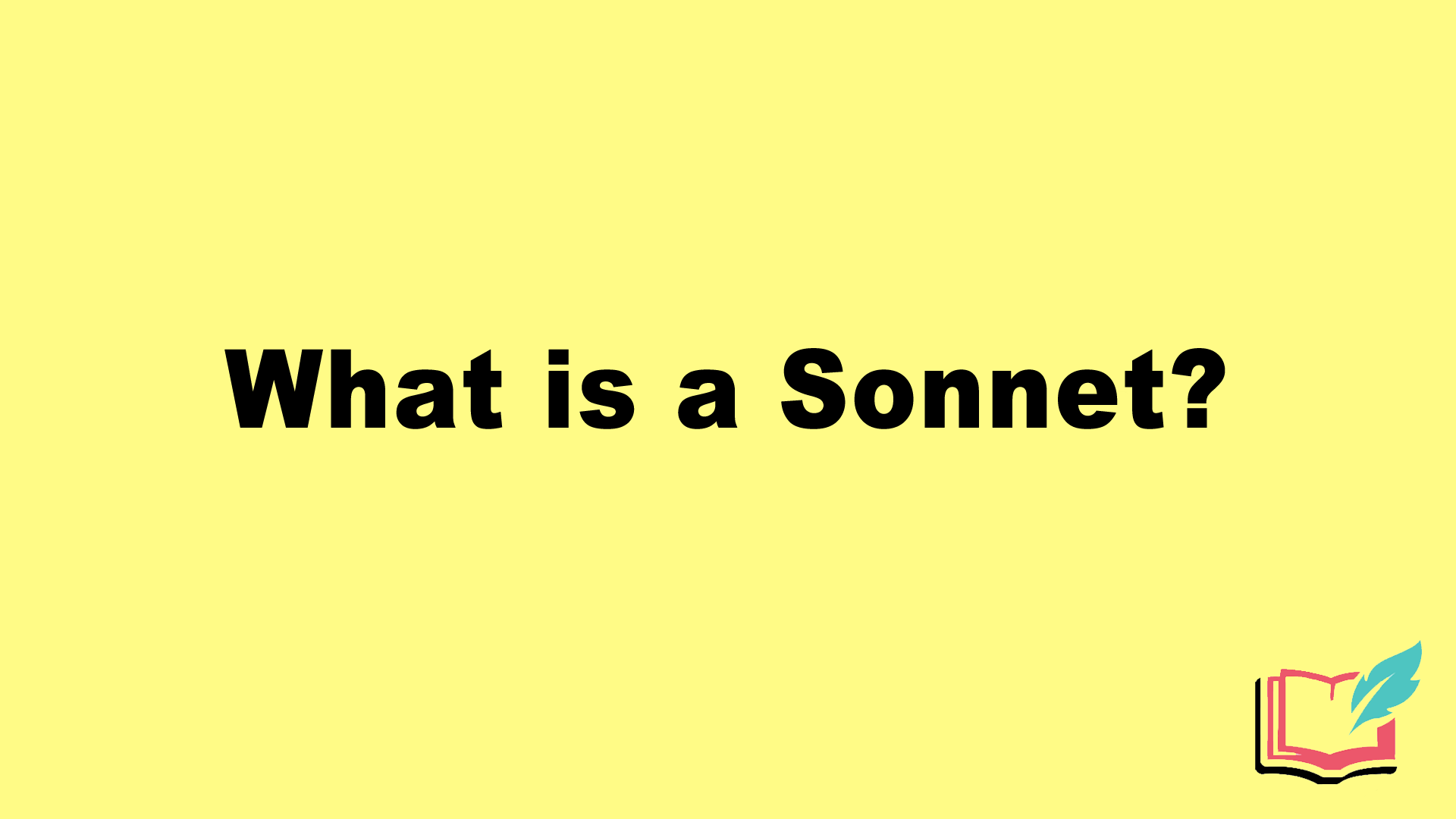
Sonnets are poems written in iambi pentameter with ten syllables in each line. Sonnets are categorized depending on what kind of rhyme scheme they use.
Types of Sonnets
There is a wide variety of types of sonnets that you should be aware of when studying this type of poem.
Italian Sonnet – Also known as the Petrarchan Sonnet, these sonnets feature the first eight lines, the octet, using an abba-abba-cdc-dcd rhyme scheme while the following six lines, the sestet, using any range of rhyme schemes. Consider the following poem “The New Colossus” by Emma Lazarus:
Not like the brazen giant of Greek fame, (a)
With conquering limbs astride from land to land; (b)
Here at our sea-washed, sunset gates shall stand (b)
A mighty woman with a torch, whose flame (a)
Is the imprisoned lightning, and her name (a)
Mother of Exiles. From her beacon-hand (b)
Glows world-wide welcome; her mild eyes command (b)
The air-bridged harbor that twin cities frame. (a)
‘Keep, ancient lands, your storied pomp!’ cries she (c)
With silent lips. ‘Give me your tired, your poor, (d)
Your huddled masses yearning to breathe free, (c)
The wretched refuse of your teeming shore. (d)
Send these, the homeless, tempest-tost to me, (c)
I lift my lamp beside the golden door! (d)
Shakespearean Sonnet – This type of sonnet is written in iambic pentameter, in which there are ten syllables per line. The rhyme scheme of this sonnet is a challenging abab-cdcd-efef-gg. Only Shakespeare is known to have consistently written in this style. Check out “Sonnet 10” by William Shakespeare:
For shame deny that thou bear’st love to any, (a)
Who for thyself art so unprovident. (b)
Grant, if thou wilt, thou art beloved of many, (a)
But that thou none lovest is most evident; (b)
For thou art so possess’d with murderous hate (c)
That ‘gainst thyself thou stick’st not to conspire. (d)
Seeking that beauteous roof to ruinate (c)
Which to repair should be thy chief desire. (d)
O, change thy thought, that I may change my mind! (e)
Shall hate be fairer lodged than gentle love? (f)
Be, as thy presence is, gracious and kind, (e)
Or to thyself at least kind-hearted prove: (f)
Make thee another self, for love of me, (g)
That beauty still may live in thine or thee. (g)
Spenserian Sonnet – Sir Edmund Spenser ventured to modify the established Petrarchan form and introduced the rhyme scheme of abab-bcbc-cdcd-ee. The poem “Amoretti” shows this rhyme pattern.
Fresh spring! the herald of Love’s mighty king, (a)
In whose coat-armour richly are displayed (b)
All sorts of flowers, the which on earth do spring (a)
In goodly colours gloriously arrayed – (b)
Go to my love, where she is careless laid, (b)
Yet in her winters bower, not well awake; (c)
Tell her the joyous time will not be staid, (b)
Unless she do him by the forelock take: (c)
Bid her, therefore, herself soon ready make (c)
To wait on Love amongst his lovely crew, (d)
Where every one that misseth then her make, (c)
Shall be by him amerced with penance dew. (d)
Make haste, therefore, sweet Love! Whilst it is prime; (e)
For none can call again the passed time. (e)
The Purpose of Sonnets
Sonnet is a widely popular type of poem because it can be used for a variety of purposes. Due to its strict rhyme structure, it provides a framework for poets to express abstract thoughts, which makes it a popular choice for poems about love and other strong emotions. As easy as it is to follow for writers, it is equally as easy for readers to feel comfortable with.
Another aspect of sonnets that makes them favored by writers is that their structure is suited to a tone that mimics conversation. As mentioned, sonnets tend to deal with intense emotional subjects and the octet followed by the sestet tends to create a similar cadence to one person speaking and another person replying. In this way, it gives the impression that the author is having a conversation with his/herself.
Furthermore, the feeling of the sonnet goes from that of a more intense emotional outcry in the octet to a softer repose in the sestet which is aesthetically pleasing for the reader.
Literary Significance of Sonnets
Percy Shelley’s sonnet “Ozymandias” explores the concept of time and humankind’s inability to rule it. With an unconventional rhyme pattern, the poem upholds the other structural components of a sonnet such as the octet followed by a sestet with each line containing ten syllables.
I met a traveler from an antique land
Who said: Two vast and trunkless legs of stone
Stand in the desert. Near them, on the sand,
Half sunk, a shattered visage lies, whose frown,
And wrinkled lip, and sneer of cold command
Tell that its sculptor well those passions read
Which yet survive, stamped on these lifeless things,
The hand that mocked them, and the heart that fed;
And on the pedestal these words appear:
“My name is Ozymandias, king of kings:
Look on my works, ye Mighty, and despair!”
Nothing beside remains. Round the decay
Of that colossal wreck, boundless and bare
The lone and level sands stretch far away.
Famous Romantic poet John Milton wrote the sonnet “When I Consider How My Light is Spent” which reflects his tendency to reflect on life and death. The sonnet follows the classic Petrarchan rhyme scheme.
When I consider how my light is spent
Ere half my days in this dark world and wide,
And that one talent which is death to hide
Lodg’d with me useless, though my soul more bent
To serve therewith my Maker, and present
My true account, lest he returning chide;
“Doth God exact day-labour, light denied?”
I fondly ask. But Patience to prevent
That murmur, soon replies: “God doth not need
Either man’s work or his own gifts; who best
Bear his mild yoke, they serve him best. His state
Is kingly. Thousands at his bidding speed
And post o’er land and ocean without rest:
They also serve who only stand and wait.
You may be surprised to learn that William Shakespeare wrote in sonnets in some of his plays including Romeo and Juliet. Leave it to Shakespeare to use every tool in the book and to do it well, no less! Sonnets helped to enhance Shakespeare’s message and in the tragic love tale that this play tells, a sonnet is rather appropriate.
Two households, both alike in dignity,
In fair Verona, where we lay our scene,
From ancient grudge break to new mutiny,
Where civil blood makes civil hands unclean.
From forth the fatal loins of these two foes
A pair of star-cross’d lovers take their life;
Whose misadventured piteous overthrows
Do with their death bury their parents’ strife.
The fearful passage of their death-mark’d love,
And the continuance of their parents’ rage,
Which, but their children’s end, nought could remove,
Is now the two hours’ traffic of our stage;
The which if you with patient ears attend,
What here shall miss, our toil shall strive to mend.
Recap: What is a Sonnet in Literature?
A sonnet is a type of poem that is often used to present complicated emotional quandaries such as life and death, love, etc. Sonnets are structurally composed of an octet followed by a sestet, use iambic pentameter, have ten syllables to each line, and use rigorous rhyming schemes. The major types of sonnet include Italian/Petrarchan, Shakespearean, and Spenserian.
